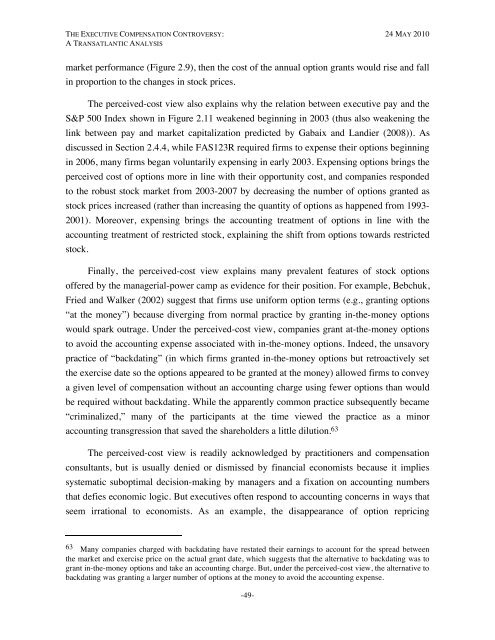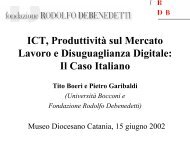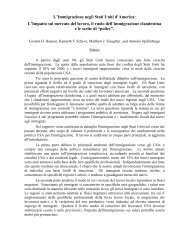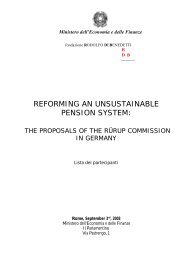The Executive Compensation Controversy - Fondazione Rodolfo ...
The Executive Compensation Controversy - Fondazione Rodolfo ...
The Executive Compensation Controversy - Fondazione Rodolfo ...
Create successful ePaper yourself
Turn your PDF publications into a flip-book with our unique Google optimized e-Paper software.
THE EXECUTIVE COMPENSATION CONTROVERSY: 24 MAY 2010A TRANSATLANTIC ANALYSISmarket performance (Figure 2.9), then the cost of the annual option grants would rise and fallin proportion to the changes in stock prices.<strong>The</strong> perceived-cost view also explains why the relation between executive pay and theS&P 500 Index shown in Figure 2.11 weakened beginning in 2003 (thus also weakening thelink between pay and market capitalization predicted by Gabaix and Landier (2008)). Asdiscussed in Section 2.4.4, while FAS123R required firms to expense their options beginningin 2006, many firms began voluntarily expensing in early 2003. Expensing options brings theperceived cost of options more in line with their opportunity cost, and companies respondedto the robust stock market from 2003-2007 by decreasing the number of options granted asstock prices increased (rather than increasing the quantity of options as happened from 1993-2001). Moreover, expensing brings the accounting treatment of options in line with theaccounting treatment of restricted stock, explaining the shift from options towards restrictedstock.Finally, the perceived-cost view explains many prevalent features of stock optionsoffered by the managerial-power camp as evidence for their position. For example, Bebchuk,Fried and Walker (2002) suggest that firms use uniform option terms (e.g., granting options“at the money”) because diverging from normal practice by granting in-the-money optionswould spark outrage. Under the perceived-cost view, companies grant at-the-money optionsto avoid the accounting expense associated with in-the-money options. Indeed, the unsavorypractice of “backdating” (in which firms granted in-the-money options but retroactively setthe exercise date so the options appeared to be granted at the money) allowed firms to conveya given level of compensation without an accounting charge using fewer options than wouldbe required without backdating. While the apparently common practice subsequently became“criminalized,” many of the participants at the time viewed the practice as a minoraccounting transgression that saved the shareholders a little dilution. 63<strong>The</strong> perceived-cost view is readily acknowledged by practitioners and compensationconsultants, but is usually denied or dismissed by financial economists because it impliessystematic suboptimal decision-making by managers and a fixation on accounting numbersthat defies economic logic. But executives often respond to accounting concerns in ways thatseem irrational to economists. As an example, the disappearance of option repricing63 Many companies charged with backdating have restated their earnings to account for the spread betweenthe market and exercise price on the actual grant date, which suggests that the alternative to backdating was togrant in-the-money options and take an accounting charge. But, under the perceived-cost view, the alternative tobackdating was granting a larger number of options at the money to avoid the accounting expense.-49-









